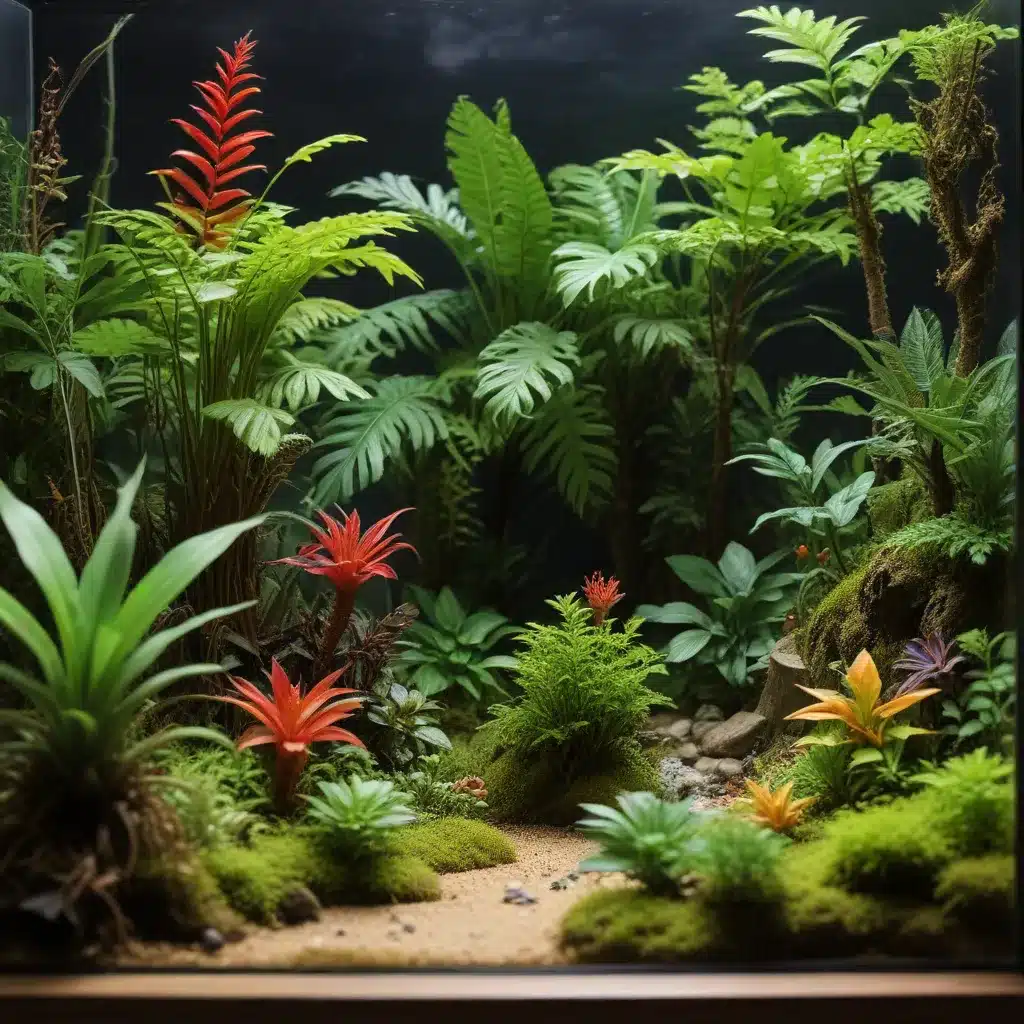
Constructing Vibrant Terrariums for Captive Reptiles
Maintaining the optimal environment for exotic reptiles is a crucial aspect of responsible pet ownership. Replicating the intricate balance of natural habitats within captive enclosures requires a deep understanding of the species’ unique needs. From recreating tropical rainforests to simulating arid desert conditions, the construction of visually stunning and functionally sound terrariums is an essential skill for any reptile enthusiast.
The key to constructing a thriving terrarium lies in meticulously recreating the environmental factors that sustain the chosen reptile species in the wild. This includes carefully regulating temperature, humidity, lighting, and substrate to mimic the animal’s natural habitat. By taking the time to research the specific requirements of each reptile, owners can create a miniature ecosystem that caters to the creature’s well-being and allows it to thrive in captivity.
Designing Optimal Terrariums for Diverse Reptile Species
Different reptile species require vastly different environmental conditions to flourish. For example, tropical rainforest-dwelling reptiles, such as certain gecko and tree frog species, thrive in warm, humid settings with dappled lighting that mimics the forest canopy. In contrast, desert-adapted reptiles, like certain species of iguana and bearded dragon, require dry, arid conditions with ample basking spots and low humidity.
When constructing terrariums for these diverse reptile species, it’s essential to consider factors such as:
- Temperature Regulation: Establishing appropriate temperature gradients, with basking areas and cooler zones, to allow the reptile to thermoregulate effectively.
- Humidity Control: Maintaining the appropriate level of humidity, whether high for tropical species or low for desert-dwellers, through the use of specialized equipment and substrate selection.
- Lighting Needs: Providing the right balance of UVA, UVB, and visible light to support the reptile’s natural behaviors, such as basking and photosynthesis in some plant species.
- Substrate and Decor: Carefully choosing substrates, plants, and decorative elements that mimic the reptile’s natural habitat and support its behavioral and physiological requirements.
By meticulously attending to these critical environmental factors, reptile owners can create thriving, vibrant terrariums that meet the unique needs of their exotic pets.
Breeding Exotic Reptiles: Considerations and Best Practices
Breeding exotic reptiles requires a deep understanding of the species’ reproductive biology and a commitment to responsible, ethical practices. Successful breeding programs not only contribute to the conservation of rare and threatened species but also provide a sustainable source of captive-bred reptiles for the pet trade.
When embarking on a reptile breeding program, there are several key considerations to keep in mind:
-
Genetic Diversity: Maintaining a diverse gene pool is crucial to ensuring the long-term health and vitality of the captive population. Careful selection of breeding pairs and the introduction of new genetic lines can help avoid inbreeding and the associated health problems.
-
Nutritional Requirements: Providing a well-balanced diet rich in essential nutrients is vital for the overall health and reproductive success of the breeding animals. This may involve supplementing the reptiles’ diet with vitamins, minerals, and other specialized supplements.
-
Environmental Cues: Many reptile species rely on specific environmental triggers, such as temperature fluctuations or changes in photoperiod, to initiate their breeding cycle. Replicating these cues in the captive setting is crucial for successful reproduction.
-
Incubation and Hatchling Care: Carefully managing the incubation of reptile eggs, including temperature, humidity, and substrate, is essential for the successful development of healthy offspring. Proper hatchling care, including the provision of appropriate habitats and nutrition, is also crucial for the long-term viability of the captive population.
By adhering to these best practices and continuously refining their breeding techniques, reptile breeders can contribute to the preservation of exotic species and provide a reliable source of captive-bred animals for the pet trade.
Legal Considerations for Exotic Reptile Ownership and Sales
The ownership and sale of exotic reptiles are subject to a complex web of regulations and legal frameworks, which vary significantly between regions and jurisdictions. Responsible reptile enthusiasts and breeders must familiarize themselves with the applicable laws and regulations to ensure they are operating within the confines of the law.
Key legal considerations for exotic reptile ownership and sales include:
-
Species-Specific Regulations: Many countries and states have specific laws governing the possession, breeding, and trade of certain reptile species, particularly those that are considered endangered or threatened. Owners and breeders must research and comply with these species-specific regulations.
-
Licensing and Permits: In many regions, the ownership and commercial sale of exotic reptiles may require specific licenses or permits. Obtaining the necessary documentation and maintaining compliance with regulatory requirements is crucial for both private owners and commercial breeders.
-
Import and Export Regulations: The international trade of exotic reptiles is often subject to strict import and export regulations, such as those outlined in the Convention on International Trade in Endangered Species of Wild Fauna and Flora (CITES). Careful adherence to these regulations is essential to avoid legal complications and ensure the ethical and sustainable trade of captive-bred reptiles.
-
Health and Welfare Standards: In some jurisdictions, there are specific requirements and standards for the housing, care, and transportation of exotic reptiles to ensure their well-being. Compliance with these standards is not only a legal obligation but also an essential aspect of responsible reptile ownership and breeding.
By staying informed about the relevant laws and regulations, reptile enthusiasts and breeders can navigate the legal landscape with confidence and contribute to the responsible management of the exotic reptile trade.
Conclusion
Mastering the art of exotic reptile husbandry requires a multifaceted approach that encompasses the creation of vibrant terrariums, the implementation of responsible breeding practices, and the diligent adherence to legal requirements. By prioritizing the well-being of their captive reptiles and staying abreast of the latest developments in the field, reptile enthusiasts and breeders can not only ensure the long-term health and vitality of their collections but also contribute to the conservation of these remarkable creatures.
For more information on exotic reptile care, breeding, and legal compliance, please visit our website at ExoticReptilesForsale.com.

